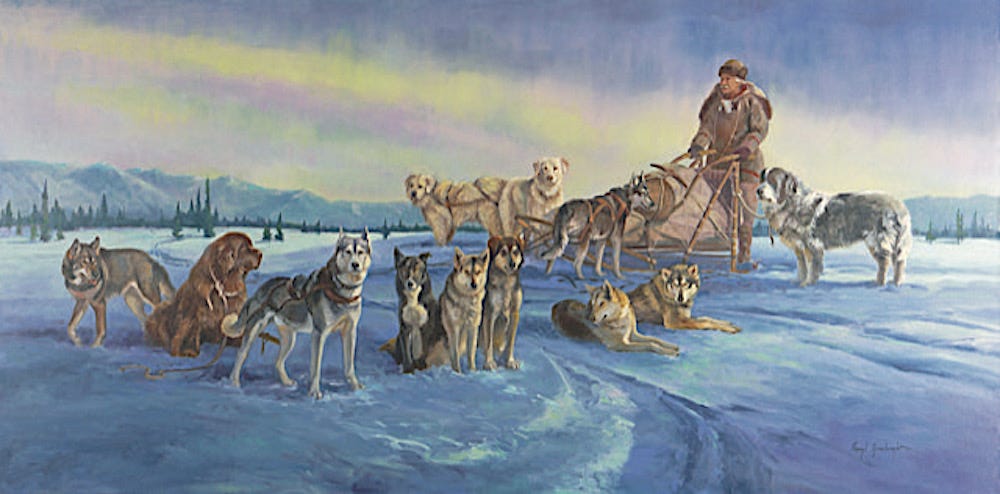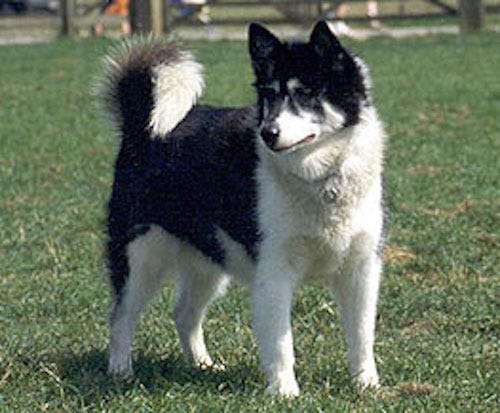
In the front matter of my book, before the parts and chapters begin, I will be including a section titled Dogs of the North, subtitled at this point Sled Dog Breeds, Types, and Other Designations. My goal is to simply set a brief introduction to the many different kinds of sled dogs in the book, not to provide comprehensive breed standards or descriptions, but merely to showcase the breadth and depth of the field from which working sled dogs arose. (I have been debating whether or not to include wolves in this section, for while they were not dogs, they were in fact used by some early dog drivers.)
There were, of course, many other breeds drafted into service as sled dogs, as illustrated so beautifully in the artwork above by my dear friend Veryl Goodnight. Newfoundlands, St. Bernards, Great Pyrenees, Collies, German Shepherds, and almost any other breed which could be put in front of a sled and expected—or forced—to pull. I am considering a catch-all category which would include these other breeds, and of course, the multi-breed mongrels who probably made up the biggest percentage of dogs pressed into service.
I am also debating that word ‘North.’ One of my primary goals with this book is to show the abundance of sled dog use outside of Alaska and Canada, but I keep finding that with few exceptions most of the dog drivers learned their skills in the north country, and most of the specific sled dog breeds were first developed in the north. Much to my chagrin, I am beginning to doubt my original premise.
Anyway, here are some of the dogs, with very brief excerpts from their multi-paragraph descriptions, and some of the photographs and images under current consideration. Still a work in progress.

Alaskan Eskimo Dogs - Excerpted from The Book of Dogs, National Geographic Society, Washington, D.C., 1919: There are a good many names for the Eskimo dogs and a good many types, as their range covers a stretch of country some 4,000 miles long and 1,500 miles wide. It is therefore easily understandable that the dog of the Aleutians and Alaska should present quite a different appearance from that of Hudson Bay or Greenland.
Alaskan Husky - As dogs selectively-bred for their ability as working sled dogs, intelligence and problem-solving are highly desired and are generally marks of talented lead dogs, which are often given primary consideration for breeding. Dogs are expected to read the trail and respond to situations through instincts and experience, and thus superior cognitive abilities are often bred into Alaskan husky lines in tandem with physical athletic attributes.
Alaskan Malamute - Alaskan Malamutes, one of the oldest Arctic sled dogs, were believed to be bred by the nomadic Inuit tribe, Mahlemut, of the Kotzebue Sound of northwestern Alaska. These dogs, of unbelievable hardiness and able to work in the brutal arctic climate, were originally used to hunt seals, fend off polar bears, and haul heavy loads of food and camp supplies over great distances, albeit at low speeds.
Canadian Eskimo Dog - (see Inuit dog, Thule or Greenland dog)
Chinook - The Chinook owes its existence to one man: Klondike gold rush adventurer Arthur Treadwell Walden of Wonalancet, New Hampshire.
Greenland Dog - The Canadian Eskimo Dog is considered the same breed as the Greenland Dog since they have not yet diverged enough genetically to be considered separate breeds (see Inuit dog, Thule dog, Canadian Eskimo Dog). Today the breed is considered as nationally and culturally important to Greenland and efforts are made to safeguard its purity.
Hedlund Husky - [no description yet]
Indian Dog - [no description yet]
Inuit Dog - Although the Inuit Dog is often referred to as a "breed", its proper identification is that of a “landrace."
Labrador Husky - Over the centuries, the Labrador husky's ancestors had been cut off geographically from the other northern breeds, and developed into large, solid dogs who are strong runners, and appear to move with little effort across the snow.
Mackenzie River Husky - Since the mid-1800s, freighting dogs were generally known by their place of origin, and there were numerous distinct types of huskies throughout northern Canada and Alaska, including the Porcupine River Dogs, the Peel River Dogs, and several others. The most notable were the dogs of the Hudson's Bay Company's Mackenzie River District, and by the 1860s, they were prized throughout the region.

North Greenland Eskimo Dogs - Excerpted from The Book of Dogs, National Geographic Society, Washington, D.C., 1927: Polaris was chosen as our model of this type because he has been considered the most perfect North Greenland Eskimo dog known.
Peel River Dogs - The Mackenzie River Huskies were sometimes described as ‘Peel River Dogs’ during the Klondike Gold Rush, the Peel River being a tributary of the Mackenzie River.
Samoyed - Excerpted from The Book of Dogs, National Geographic Society, Washington, D.C., 1927. [Referred to as the Siberian Reindeer Dog in an illustration for the book by Louis Agassiz Fuentes.] The Samoyed is a compact, staunch little sledge dog used by the Samoyed, a semi-nomadic race living in northeastern Russia and Siberia. These people keep herds of reindeer, and some of the dogs are used in rounding up and driving these animals, much as collies are used in caring for sheep and cattle.
Seppala Siberian Husky - [no description yet]
Siberian Husky - In the fall of 1908 a Russian fur trader named William Goosak brought a new breed of sled dogs to Nome, Alaska from his homeland in northeast Asia. Bred for centuries by the indigenous Chukchi people of Siberia, these small, fleet-footed, active and energetic dogs were prized for pulling sleds and for companionship.
Thule Dog - (see Inuit dog, Thule/Greenland dog, Canadian Eskimo Dog)

Scheduled for publication in the fall of 2022 by Northern Light Media, The History of Sled Dogs in North America, by Helen Hegener and several contributing writers, will highlight the working sled dogs which helped shape the future of the continent.



